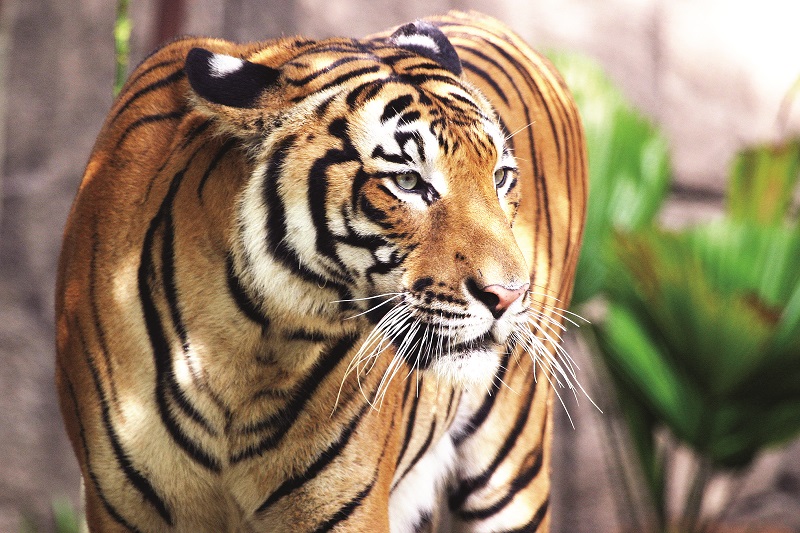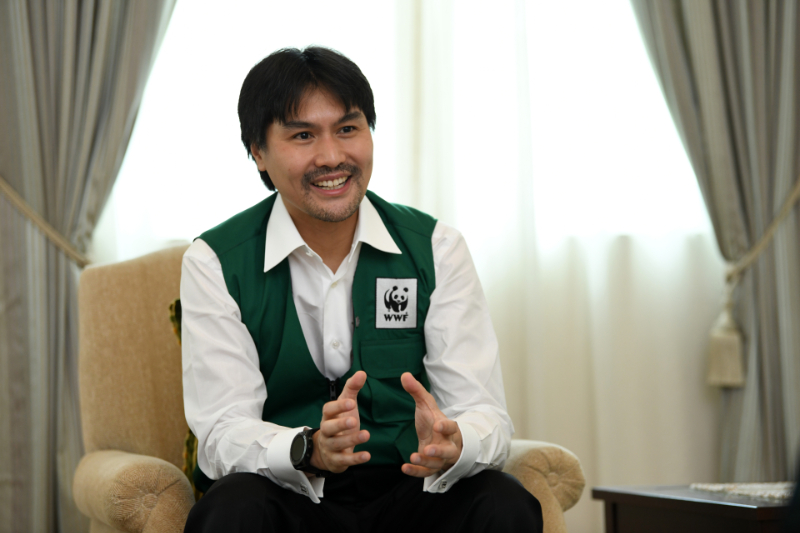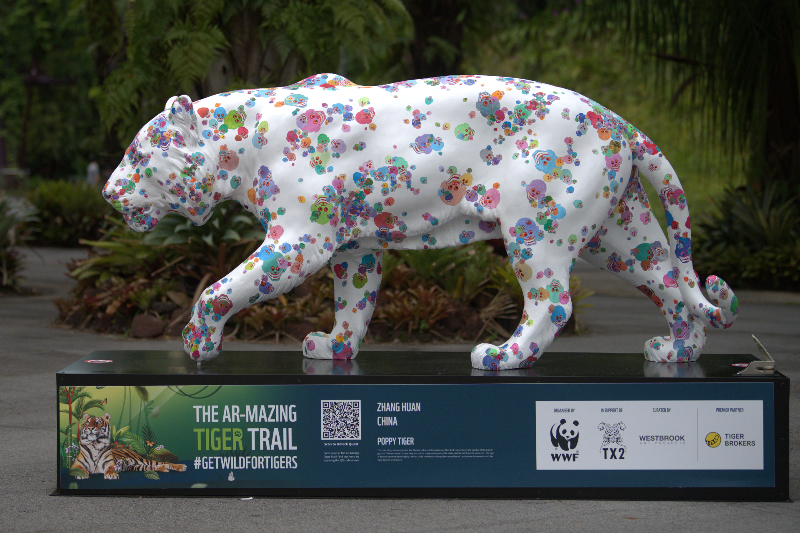
Tunku Ali is privy to facts about tigers, and the figures are far from rosy (Photo: Low Yen Yeing/ The Edge Malaysia)
Malaysia is among the 13 range countries in which tigers still roam in the wild. From folklore about humans shapeshifting into weretigers (harimau jadian) to Harimau being outwitted by wily Sang Kancil the mousedeer to Kipling’s (and Disney’s) Shere Khan waiting to get his claws on the man-cub Mowgli, impulsive Tigger bouncing around Winnie the Pooh, or William Blake’s paean to its beauty and symmetry, the tiger is both feared and revered for its looks, ferocity and power. Tigers also adorn our national coat of arms, and the Harimau Malaya lends its name to the country’s football team.
Asked whether he has a tiger memory, Tunku Ali Redhauddin ibni Tuanku Muhriz remembers the drive back to Seri Menanti while growing up, trips that took him along a winding, uphill road that passed through a place called Bukit Putus, between Seremban and the royal town.
“I always wondered where the name came from. As it turns out — and this was a story my grandmother related to me as a young boy — Bukit Putus was actually one mountain where there were two tigers. They had a fight and, as a result, the mountain broke apart.
“To this day, when I pass through Bukit Putus on my weekly drives back to Seri Menanti, that memory of tigers fighting on a hill inadvertently still comes back to me. It is interesting that even in legend, the natural world was intertwined with tigers, which literally helped shape the environment.”
There were also stories about weretigers in various communities, one of which was said to have guarded over Seri Menanti. “They were generally forces of good helping people in the community,” he adds.
“Cats always fascinated me — I grew up with many pet cats — and that fascination extended to the big cats, especially tigers, whose strength and majesty inspired me. The symbol of what they represent is etched in my memory.”
As chairman and a trustee of the World Wide Fund for Nature Malaysia (WWF-MY), Tunku Ali is privy to facts about tigers, and the figures are far from rosy. Early in the 20th century, 100,000 wild tigers wandered freely on Earth. Rampant poaching and habitat loss have depleted their numbers and about 3,900 of these creatures remain today. There are fewer than 150 Malayan tigers and the species faces imminent danger of extinction — unless the whole nation pitches in to save them, the organisation warns.
malayan_tiger_3_photocredit_shariff_mohamad_wwf-malaysia_1.jpg

Tunku Ali is at the tail end of his second term at WWF-MY, which he joined eight years ago. He says a lot has been done in the last decade to bring the organisation forward concerning governance and leveraging corporate experience to make operations more efficient. Many things have been automated — he remembers how trustees needed to manually sign monthly cheques to pay staff salaries — so WWF-MY can focus on its work, which is conservation.
“When I first got here, a lot of how we thought about impact was measured primarily by how much we had spent relative to budget. As we think about performance management, it is important to understand that we should try to spend the right amount to get the required impact for what we’re trying to do.”
Work on the ground is significant, led by the conservation team and full-time management. WWF-MY has been extremely consistent in working separately as an organisation as well as engaging the government in different areas across Peninsular Malaysia, especially in areas such as tiger conservation, forest management and sustainable palm oil.
Tigers are highly valued in the illegal wildlife market, and poachers are further incentivised by the street value of products made from their body parts, traditionally prized for their healing properties.
To stamp out poaching, WWF-MY launched Project Stampede in 2018, which involved recruiting 15 teams of 75 Orang Asli rangers to constantly patrol the Belum-Temengor Forest in Perak to track and remove traps placed by poachers. At the end of each 15-day stint, the teams regroup at the field base to deposit information collected from handheld GPS units and record their findings into a database.
From 2019 to 2021, these expert jungle trekkers covered more than 33,000km on foot, a distance equivalent to more than 90 trips between Kuala Lumpur and Singapore. They also set up camera traps to ascertain the presence of the animals and monitor the status of tigers and their prey.
Technology has enabled WWF-MY’s team to map forests and deforested areas, as well as identify spots where tigers are detected. Accurate maps allow them to plan ahead and work with governments and plantations to determine where wildlife corridors can be built and where to reforest. They also tag turtles and elephants by putting satellite collars on them to track their movements.
Project Stampede has resulted in a 90% decrease in the number of poachers’ snares found. What makes the rangers even more excited is that over the last year, camera traps have captured photos of tigers and their cubs, indicating that the animals are healthy and able to breed. An average litter is two to four cubs and the gestation period is about 3½ months. But tigresses usually wait 18 to 24 months between births.
WWF-MY has also been working on wildlife corridors to allow wild animals to move from different green areas. In the marine space, it has joined hands with various authorities to get marine parks gazetted.
closeup_20220406_peo_tunku_ali_redhauddin_ibni_tuanku_muhriz_23_lyy.jpg

One of the challenges that it faces is making sure each tiger has enough range to roam. In that respect, Malaysia is lucky because there is connectivity between its forested areas. “We have a central forest spine that acts as a conduit through which wildlife can move from the north down to the south. We need to ensure that this connectivity continues so they can travel without causing conflict with humans,” Tunku Ali says.
While work in the field is important, advocacy — the second part of its tiger conservation programme — is crucial, he emphasises. The organisation has produced documentaries and literature and made public appeals concerning the plight of the Malayan tiger. In February 2019, it was invited to present its case for the species, our national symbol, to a pre-meeting of the Conference of Rulers.
“We had 3,000 of these animals at the time of our independence. Today there are fewer than 150, the result of years of deforestation and poaching. It is very distressing.”
Raising awareness of tiger conservation at the highest level has led to results and made the team hopeful, even though they know there is much more to do.
Going back to Bukit Putus, Tunku Ali muses: “One could almost imagine going for a walk in the jungle and spotting a tiger, but not come face to face with it in an aggressive way. That is hardly likely to happen now.” But as part of the global network of tiger range countries working on various initiatives in the past 12 years, the Malaysian branch has seen a lot of success.
“In India, Nepal and Bhutan, they have reversed the trend of declining tiger numbers to actually increasing them. That is something other countries can take comfort in. But the time to act is now. If the decline dips below a certain threshold, it [will be] almost impossible to recover.”
WWF-MY has been active in tiger conservation since 2008, though the sense of urgency at a national level increased significantly only in the last six years, he notes. Project Stampede and other initiatives have seen the police department, armed forces and government flexing their muscles to deter poachers. Following an amendment enacted last year, those found guilty can face up to 15 years’ jail and a fine of up to RM1 million.
A better understanding of the importance of tiger conservation projects has led to increased government funding for efforts to boost their numbers. For example, Malaysia is spending RM37 million to engage 1,000 rangers and deploy them throughout forests to scare off poachers.
“Just in terms of scale, the impact will be very significant, as they can cover much more ground,” Tunku Ali says.
“Governments, both state and federal, make the decisions and, as such, their support is important. We can be advocates but, ultimately, it’s the government that can move the needle significantly.”’
WWF-MY sits on different committees that are government-led and there are other NGOs doing things to protect tigers, such as the Wildlife Conservation Society and MYCAT (Malaysian Conservation Alliance for Tigers). “I’m less concerned about who takes the lead — the end goal is the same, and efforts should be coordinated. It’s more about achieving the mission.”
Awareness of deforestation and habitat loss, problems that have persistently forced tigers out of their homes, is much higher now and there are many initiatives to stop and reverse the trend. But the approach needs to be inclusive, and not at the expense of other sectors. As Tunku Ali puts it, “Why I like working with WWF-MY is that it recognises development has to happen [alongside conservation]. If people’s livelihoods are not improved, that in itself is not sustainable. So, whatever happens needs to be done on a balanced level.”
One of the things WWF-MY has done quite well is its three-pronged approach to living landscapes: protect, produce and restore.
“We protect what we already have. We produce things by looking at the picture holistically. We cannot ignore that we need to progress as an economy and a country, but the way is to do it sustainably.” The last prong, restore, involves reforesting degraded areas and ensuring connectivity between the forested areas.
Malaysia is quite fortunate in that it has relatively vast forest cover — 54% throughout the country and 43% in the peninsula. The target is to get back to 50% in the latter, he explains.
Tunku Ali is confident about leaving WWF-MY in good hands when he steps down as chairman this year. “We have been active here since 1972 and have about 200 people in the organisation. All our trustees are volunteers.
“I’d like to think we have put together a board of passionate individuals across many different walks of life. The organisation has representatives from East and West Malaysia and a good mix of conservation champions, academics and people with more corporate backgrounds to help with governance and fundraising.”
The organisation is better funded now than it was eight years ago, but not so flush that it can do anything it wishes. “There’s always a balance: We spend what we can. We want to be successful in the work that WWF-MY does, but if we can raise more money for specific initiatives, like protecting the tigers, there is much more we’d like to do.”
Fundraising is part of its advocacy work because WWF-MY relies heavily on the goodwill of Malaysians to keep it afloat. There are five main sets of donors, with the largest comprising the rakyat of 70,000 individuals. This shows a growing awareness among the public. “I want to thank each and every one of you, our individual donors,” Tunku Ali says.
The next group are corporate donors, among them Maybank, CIMB Islamic, P&G, Unilever and HSBC, big supporters for years.
zhang_huan1_kaustubh_srikanth.jpg

A third source is the WWF network itself. Because of its significant biodiversity and conservation work, Malaysia attracts funding from other countries as well as Switzerland-based WWF International. European affiliates such as Germany, the Netherlands and the UK reach out with aid, as do Singapore and Japan. But it is not automatic, Tunku Ali quickly adds. “You have to apply and compete with other initiatives around the world.”
Government funding is the fourth channel, particularly for projects related to sustainability. A fifth arm rests somewhere between the individual and corporate donors. These are wealthy individuals or family offices that feel very strongly about certain causes and donate significantly towards them. “We have a few of these locally and from Thailand and Singapore.”
The island state was the venue of WWF’s Tiger Trail 2022 exhibition, featuring 33 life-sized tiger sculptures and more than 20 art pieces by 60 artists from 14 countries, to raise awareness of and funds to halt the rapid decline of their populations. Marking the conclusion of the trail, WWF, together with Sotheby’s, is holding an online auction of those exhibits until May 5.
Tunku Ali finds that art, as a medium, works well in terms of raising awareness among those who have influence in communities to support initiatives to protect the tiger. Malaysia will be a beneficiary of the event. “I might bid for a couple of the smaller pieces,” he quips.
He looks forward to International Tiger Day, on July 29, to further advocate WWF’s agenda. The organisation marks the day annually “and this being the Year of the Tiger, we want to do something exciting. Watch this space and support us.”
Going back to the majestic big cats, Tunku Ali reckons they are so pervasive in our country and culture because of what they represent. “It would be a shame for our children if the tiger became just a mythical animal.”
And ironic, too, like England having the lion on its coat of arms and its national football team being hailed as the Lions. “But there are no lions in England now. They’re all gone. So, let us keep our tigers and ensure that habitats exist for them to thrive.”
WWF held the Tiger Trail 2022 exhibition in Singapore featuring 33 life-sized sculptures and more than 20 art pieces inspired by the big cat. Marking the conclusion of the trail, WWF, together with Sotheby’s, is holding an online auction of those exhibits until May 5. For more information, visit sothebys.com.
This article first appeared on Apr 18, 2022 in The Edge Malaysia.


